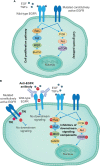Engaging innate immunity for targeting the epidermal growth factor receptor: Therapeutic options leveraging innate immunity versus adaptive immunity versus inhibition of signaling
- PMID: 36185288
- PMCID: PMC9518002
- DOI: 10.3389/fonc.2022.892212
Engaging innate immunity for targeting the epidermal growth factor receptor: Therapeutic options leveraging innate immunity versus adaptive immunity versus inhibition of signaling
Abstract
The epidermal growth factor receptor (EGFR) is a key player in the normal tissue physiology and the pathology of cancer. Therapeutic approaches have now been developed to target oncogenic genetic aberrations of EGFR, found in a subset of tumors, and to take advantage of overexpression of EGFR in tumors. The development of small-molecule inhibitors and anti-EGFR antibodies targeting EGFR activation have resulted in effective but limited treatment options for patients with mutated or wild-type EGFR-expressing cancers, while therapeutic approaches that deploy effectors of the adaptive or innate immune system are still undergoing development. This review discusses EGFR-targeting therapies acting through distinct molecular mechanisms to destroy EGFR-expressing cancer cells. The focus is on the successes and limitations of therapies targeting the activation of EGFR versus those that exploit the cytotoxic T cells and innate immune cells to target EGFR-expressing cancer cells. Moreover, we discuss alternative approaches that may have the potential to overcome limitations of current therapies; in particular the innate cell engagers are discussed. Furthermore, this review highlights the potential to combine innate cell engagers with immunotherapies, to maximize their effectiveness, or with unspecific cell therapies, to convert them into tumor-specific agents.
Keywords: CAR-T therapy; adaptive immunity; bispecific antibody; cancer; epidermal growth factor receptor; innate cell engager; innate immunity; tyrosine kinase inhibitor.
Copyright © 2022 Hintzen, Dulat and Rajkovic.
Conflict of interest statement
All authors are employees of Affimed GmbH. The authors declare that this study received funding from Affimed GmbH. The funder had the following involvement with the study: funded the writing assistance.
Figures




Similar articles
-
Preclinical evaluation of AFM24, a novel CD16A-specific innate immune cell engager targeting EGFR-positive tumors.MAbs. 2021 Jan-Dec;13(1):1950264. doi: 10.1080/19420862.2021.1950264. MAbs. 2021. PMID: 34325617 Free PMC article.
-
Redirected optimized cell killing (ROCK®): A highly versatile multispecific fit-for-purpose antibody platform for engaging innate immunity.MAbs. 2019 Jul;11(5):899-918. doi: 10.1080/19420862.2019.1616506. Epub 2019 Jun 7. MAbs. 2019. PMID: 31172847 Free PMC article.
-
Dual-agent molecular targeting of the epidermal growth factor receptor (EGFR): combining anti-EGFR antibody with tyrosine kinase inhibitor.Cancer Res. 2004 Aug 1;64(15):5355-62. doi: 10.1158/0008-5472.CAN-04-0562. Cancer Res. 2004. PMID: 15289342
-
Epidermal growth factor receptor inhibition strategies in oncology.Endocr Relat Cancer. 2004 Dec;11(4):689-708. doi: 10.1677/erc.1.00600. Endocr Relat Cancer. 2004. PMID: 15613446 Review.
-
[99mTc]Epidermal growth factor receptor–specific nanobody.2008 Apr 22 [updated 2008 May 13]. In: Molecular Imaging and Contrast Agent Database (MICAD) [Internet]. Bethesda (MD): National Center for Biotechnology Information (US); 2004–2013. 2008 Apr 22 [updated 2008 May 13]. In: Molecular Imaging and Contrast Agent Database (MICAD) [Internet]. Bethesda (MD): National Center for Biotechnology Information (US); 2004–2013. PMID: 20641885 Free Books & Documents. Review.
Cited by
-
Immunotherapeutic progress and application of bispecific antibody in cancer.Front Immunol. 2022 Oct 20;13:1020003. doi: 10.3389/fimmu.2022.1020003. eCollection 2022. Front Immunol. 2022. PMID: 36341333 Free PMC article. Review.
-
Selection of bispecific antibodies with optimal developability using FcRn‑Ph‑HPLC as an optimized FcRn affinity chromatography method.MAbs. 2023 Jan-Dec;15(1):2245519. doi: 10.1080/19420862.2023.2245519. MAbs. 2023. PMID: 37599441 Free PMC article.
-
Epidermal Growth Factor Receptor Targeting in Colorectal Carcinoma: Antibodies and Patient-Derived Organoids as a Smart Model to Study Therapy Resistance.Int J Mol Sci. 2024 Jun 28;25(13):7131. doi: 10.3390/ijms25137131. Int J Mol Sci. 2024. PMID: 39000238 Free PMC article. Review.
References
-
- The human protein atlas. Available at: https://www.proteinatlas.org/ENSG00000146648-EGFR/tissue (Accessed 8 February, 2022).
-
- Yano S, Kondo K, Yamaguchi M, Richmond G, Hutchison M, Wakeling A, et al. . Distribution and function of EGFR in human tissue and the effect of EGFR tyrosine kinase inhibition. Anticancer Res (2003) 23(5a):3639–50. - PubMed
-
- Real FX, Rettig WJ, Chesa PG, Melamed MR, Old LJ, Mendelsohn J. Expression of epidermal growth factor receptor in human cultured cells and tissues: relationship to cell lineage and stage of differentiation. Cancer Res (1986) 46(9):4726–31. - PubMed
Publication types
LinkOut - more resources
Full Text Sources
Research Materials
Miscellaneous

